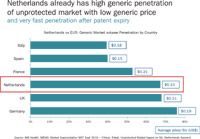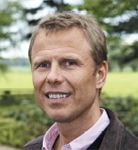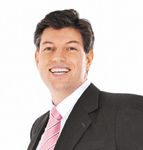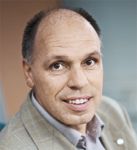The Netherlands: Innovation through Collaboration
Despite its dimunitive size, the pharmaceutical industry looks to the Netherlands for a world-class medical infrastructure, new standards in innovation, and a closely-knit community of stakeholders
This sponsored supplement was produced by Focus Reports.
Project Director: Elyse Deutscher
Editorial Coordinator: Manuel Felipe B. Mendoza
Contributors: Koen Liekens, Irina Afanassenko & Leonardo Barquero
For exclusive interviews and more info, please log onto Pharma.FocusReports.net or write to contact@focusreports.net
Despite its diminutive size, the Netherlands has historically carried a large weight in the world because of certain cultural endowments: small but united, entrepreneurial, innovative, and externally oriented. During the Dutch Golden Age, the "Low Country" monopolized international trade and commerce, giving rise to tulip manias, artistic masters, and the world's first multinational corporation. Though the sun has long set on that era, the historic imprint of the Netherlands' open mindedness to the world defines its present industrial standing. Today, the pharmaceutical industry looks to the Netherlands for a world-class medical infrastructure, new standards in innovation, and a closely-knit community of stakeholders. Like many countries, the Netherlands will need to adopt new approaches to tackle the increasing challenges of cost-containment pressures and fiscal austerity. But as history has proven, "going Dutch" has come to mean a proactive nature and ambitious attitude that makes no challenge too big.

The Night Watch, Rembrandt van Rijn, Rijksmuseum, Amsterdam
SMALL IS BEAUTIFUL
At an initial glance the Netherlands might not seem like the most attractive of pharmaceutical markets. Sandwiched in between big brothers France, Germany, and the United Kingdom, a modest population of over 16.5 million Dutch inhabitants hardly drives global growth for multinationals. But it is precisely the assets derived from a small market, mixed with a unique Dutch identity, that makes the Netherlands an ideal destination for international commerce, pharmaceuticals included.
That the Netherlands is a country literally built on ingenuous innovation goes a long way in explaining the creative flair of the culture. Inhospitable below-sea-level conditions bred infrastructural novelties in the form of iconic windmills and Amsterdam's dizzying array of canals. Cooperation, collaboration, and coalition-building were essential for survival. Furthermore, the country's rich history as a trader nation engendered a sharp commercial instinct. Translated to today's pharmaceutical industry, ingenuity, collaboration, and commercial prowess are embodied in a "build, bundle, and benefit" approach—the three-pillar strategy of the Dutch life sciences and health sector to combine the country's strong research talents with commercial opportunities through public/private partnerships and various investment vehicles.

Minister Edith Schippers, the Netherlands Minister of Health
"We are very good at the way of doing research, clinical research predominantly," says Dr. Michel A. Dutrée, general manager of Nefarma, the leading association for research-based pharmaceutical companies in the Netherlands. "The Netherlands has invested heavily in clinical research infrastructure that is based in universities and the country's top hospitals. We have almost 28 top clinical hospitals whose excellent medical specialists provide valuable research for industry. Our research strength and good relationships with biotech firms and universities is a major reason why big and intermediate pharmaceutical companies are interested in the Netherlands."
Further underpinning the attractiveness of the Netherlands for pharmaceutical and life sciences companies is a strong pipeline of top-level talent. Dutch education levels are consistently ranked among the highest in the world. A 2007 Global Talent Index of the Economist Intelligence Unit placed the Netherlands third (after the US and Canada) in its ability to attract and promote talent. Similarly, in the 2008 Times Higher Education World University Rankings, 11 of the Netherlands' 12 universities ranked among the world's top 200.
As Dutrée explains, "In contrast to other European countries, we have a network of universities here. Rather than competing with each other, Dutch universities work together since, ultimately, they are all government financed. Private financing streams do exist for Dutch universities, but base funding all comes from the government. It is very easy for government and industry to work together in the Netherlands since we are such a small country. The collaboration between the two entities is very pleasing for government."

Dr. Michel A. Dutrée, General Manager, Nefarma
"A typical and more traditional Dutch strength that comes from being a small country is to be very internationally oriented with an inclination for going all over the world," assesses Jan Wisse, managing director of Niaba, a leading Dutch biotechnology association. Consistent with this trait, approximately 87 percent of Dutch over age 15 speak English, 65 percent speak German, and 25 percent speak French, according to the Ministry of Economic Affairs. Strength in small numbers, ingenuous innovation, and openness to the world have indeed branded the Netherlands as a gateway to Europe. Top 50-pharmaceutical companies such as Amgen and Genzyme have chosen the country as its headquarters for European activities.
PHARMA IN THE LOCAL CONTEXT
Most pharmaceutical executives rank the Netherlands as first among the "next tier" of European markets behind France, Germany, Italy, Spain, and the UK. "The Netherlands has been for years a significant market for the international pharmaceutical industry," states Michael Dumas, country manager of the Italian pharmaceutical giant Menarini in the Netherlands, "not by volume and turnover, but through the innovative character, the high level of carrying out clinical studies, the level of planning and organization, and infrastructure in the country." Translated to the bottom line, Curd Lejaegere, managing director of Daiichi-Sankyo Benelux, notes that "financial performance for pharmaceuticals in the Netherlands typically has slow uptakes, but continuous growth. Other markets have initial steep curves which eventually flatten out after two years. Initial returns and results take longer in the Netherlands, partly driven by entrance guidelines or initial market accessibility constraints, but continuous growth can be counted on."

Netherlands already has high generic penetration of unprotected market with low generic price and very fast penetration after patent expiry
According to Nefarma, pharmaceuticals generated $4.88 billion (€3.55 billion) in total revenues in 2009. Employing over 50,000 people—27 percent in R&D—and accounting for 9 percent of private Dutch R&D investment, a 2010 study by Roland Berger Strategy Consultants cites the high-quality, cost-effective healthcare that pharmaceuticals provide by imparting health and wealth to Dutch society. Cost-effective is a defining term for pharmaceuticals in the Netherlands. The same study concluded that in 2008, the Netherlands spent only $430 (€313) per person on medicines—10 percent below the European average. In 2010, pharmaceutical expenditures were estimated to account for only 9 percent of the €60 billion ($82.5 billion) total Dutch healthcare budget, similarly low for European averages. Largely driving these trends is a greater than 70 percent generic penetration rate, among the highest in Europe. Generic penetration, however, is just a piece of what many local executives describe as the unsustainable pressures of cost-containment in the Netherlands today.
A TURNING POINT
Despite enviable research infrastructure and a knowledge economy that are conducive for the pharmaceutical industry in the Netherlands, enormous cost-containment pressures make it difficult to bring products to market with favorable returns.
The Netherlands underwent a major overhaul in 2006 by implementing a universal insurance mandate to curb soaring healthcare costs. Previously a public system, the Health Insurance Act of 2006 required every Dutch citizen to purchase health coverage from a private insurer, with the government establishing quality of care guidelines. The theory behind managed competition was for providers to attract as many patients as possible and allow freedom of mobility across insurers to stimulate better quality care.

Dr. Uloff Münster, Managing Director, Merck
Successfully, compulsory insurance now covers all but approximately 1 percent of the Dutch population. However, a negative side-effect since 2006 has been a preponderant shift in deciding power to the health insurers who are neither equipped nor incentivized to uphold quality. A growing one-sided cost focus on reforms risks overshooting its initial objectives and jeopardizes the long-term sustainability of pharmaceutical care.
PENNY WISE, POUND FOOLISH?
Managed competition has effectively increased the buying power of insurers without a concurrent rise in advising power by pharmaceutical companies. The generics industry has been hit particularly hard by a cost-containment "preference policy." In 2006 "along came a new stakeholder to the table called health insurance companies, which made this business completely different," says Kalman Petro, managing director of Actavis Benelux, No. 3 in the Dutch generics market. The preference policy means that when a number of medicines contain the same active agent, only the cheapest medicine—the "preferred product"—is reimbursed, as decided by the insurance companies rather than physicians or pharmacists. This has created deflationary pressures with prices being pushed to their lowest. The policy has realized noticeable returns, with generics prices dropping over 53 percent from May 2003 to April 2010, according to Roland Berger. But the industry has reached a dangerous point in which cheaper prices are doing more harm than good.
Some manufacturers have stopped making certain economically unviable products, moving the picture away from healthy competition to uncertainty of supply. When a manufacturer has cornered the lowest price of a medicine, within one to two months they find themselves having to supply far greater quantities, regardless of production capacity. Petro recalls "one company that reduced the price of a product below the 5 percent bandwidth. Suddenly a small preferred company with less than 1 percent market share was responsible for supplying 80 to 90 percent of the total market. Companies are not going to order products if they are not preferred, which makes things very dangerous. The customer—the patient—is suffering."

The Merck Netherlands team
Offering his view of the preference policy, Dr. P.F. Bongers, chairman of Bogin, the Dutch generics association assesses that "for the generics industry, if only the lowest price possible is the guiding principle next to long periods of preference, then you are endangering the continuity and quality of supply. Our aim is for fair market competition, but the preference system is not stimulating normal market competition within generics."
UPHILL FOR THE INNOVATORS
R&D companies are equally squeezed by price pressures between generics penetration affecting reimbursement schemes and the maximum price levels for their medicines. Introduced in 1991, the GVS system is a reimbursement price for therapeutically interchangeable drugs. Medicines with equivalent modes of action are clustered into one group, with the average price calculated based on comparable doses. The first price below the average is the reimbursement price. With such high generic penetration, traditional lines for R&D companies in the Netherlands such as primary care have become relatively small. As Uloff Münster, managing director of Merck-Serono in the Netherlands explains, "The most important step is to get to the reimbursement stage. This is a market-specific issue because copayments are not well accepted in the Netherlands, unlike in other European countries. If a medicine is not reimbursed in this country, the introduction of this new medicine does not make much sense."

Ferring HQ, St. Prex, Switzerland
The maximum price for pharmaceuticals in the Netherlands is determined by the average prices of comparable drugs from four reference countries: Belgium, France, Germany, and the UK. With a reference pricing arrangement, the tenuous macroeconomic situation sweeping Europe can have a potentially destabilizing effect on pharmaceuticals in the Netherlands. Han Brouwer, general manager of orphan drug specialist Actelion's Dutch affiliate, explains, "We have a very tight economic situation here, much like the rest of Europe. European Union countries that are running into financial difficulties are now cutting healthcare costs. Because our reference pricing is based on a basket of countries, we will face price cuts due to the fact that other countries have to decrease their healthcare prices for economic reasons. The price/quality phenomenon in the pharmaceutical business is eroding dramatically."
A tricky road remains for the Dutch pharmaceutical industry and the Ministry of Health, Welfare, and Sport. They must soundly manage austerity plans in the face of aging populations and rising healthcare costs while continuously incentivizing innovation for biopharmaceutical companies. Annual spending on healthcare is forecast to reach $76.5 billion (€55.7 billion) by the end of 2010, a 12 percent increase from 2005. In October 2010 a new conservative government came to power to manage these challenges. The atmosphere they inherit will see total expenditure on health and welfare services rise 3.3 percent to reach €63 billion ($87 billion) in 2011, according to the Ministry of Health, Welfare and Sport. Certain austerity measures in the 2011 budget will impact the reimbursement of certain drug classes and save approximately €32 million ($44 million) for health insurers.
FROM CRISIS SPRINGS OPPORTUNITY
Despite cost-containment measures that have been exacerbated with the greater role that health insurance companies have come to play in the system, there are some advantages.

Erik Lommerde, General Manager, Novo Nordisk
Most immediately, it has emboldened companies, inciting some to raise their voices in defiance of reforms and motivating them to succeed in the face of regulatory barriers. "The Dutch environment still challenges Menarini to maintain the level of investments, hoping that access to new medicines will be more driven by the general opinion of Europe," says Dumas. "Finding the right balance between the system's sustainability and fair prices rewarding innovation is critical and far from easy." Proudly present in over 110 countries and initially drawn to the Netherlands in 1996 because of high-quality infrastructure, organization of healthcare, and top-level physicians, Menarini's commitment to a vast international presence guarantees a committed fight for its established product lines in the Netherlands.
The added layer of a payer body has also forced pharmaceutical companies to be more methodical and meticulous in presenting the pharmacoeconomic value of their products. This has indeed penetrated the commercial mentality of Merck-Serono, a market leader in the Netherlands through biotechnology products in fertility, neurodegenerative disorders, and oncology. According to Münster, "The new landscape will increase the complexity of any decision-making process which already is not so easy in this country. There are lots of bodies involved and various layers to work through in order to come to a reimbursement decision. We as an industry, and Merck as a company, need to better understand what drives these decisions. We need to understand in the larger sense what will make the future pharmaceutical world tick." He adds that as a result, "we will need to increase our effort to strongly document not only the long-term clinical value of our new products, but also the pharmacoeconomic value. It will not be enough to show only clinical data in the future."
Ultimately, the right products in niche markets will always drive growth, even in the face of cost-containment, as experienced by Italian-based Chiesi. The Netherlands was one of Chiesi's first startup affiliates outside of Italy, according to general manager Maurits Huigen. Established in 2007, immediately after structural reforms to the healthcare system, Chiesi doubled its growth in the Netherlands in its first two years on the backs of products such as Foster for respiratory care; Bramitob, a tobramycin nebulization solution for the treatment of chronic lung infections; and Curosurf for the treatment of respiratory distress symptom in premature babies.

Dr. Bernhard Sixt, President & CEO, Agendia
More importantly, such niche market opportunities will not limit themselves to pharmaceutical companies alone. Related companies that are able to provide improved outcomes in a cost-effective manner generally carry the potential to play an increasingly important role under budget-tight regimes. An example as such is Netherlands-based Agendia, providing breast cancer patients with what President and CEO Dr. Bernhard Sixt describes as "pathologyon-demand." Dubbed "cancer's crystal ball," the FDA-cleared MammaPrint, provides physicans with a breast cancer recurrence test that will identify those patients where chemotherapy or hormonal therapy will work. "Mamma-Print reduces the incidence of unnecessary treatment and improves the quality of treatment for those who do need it. Medical costs are reduced, patients receive better care, and many patients are spared the unnecessary burden of chemotherapy; it is truly a win-win-win situation," Sixt explains.
THE NEW PHARMA
Greater connectivity between organization and market environment speaks to an overarching theme: Pharmaceutical companies are increasingly looking to move beyond product to solution; to become a total partner rather than just a supplier. Local industry executives almost unanimously agree that this will define the "new pharma" of tomorrow. "The long-term sustainability of the business will come through our ability to show that we are able to create solutions rather than just deliver a product," says Münster.

Alie Tigchelhoff, Managing Director, Utrecht Science Park
Local industry executives almost unanimously agree that this will define the new pharma of tomorrow. "Just a product is not enough. New pharma needs to be solution-oriented rather than focusing only on the pharmaceutical 'hardware'—that is, the product," says Münster. "On top of that, there should not be the slightest doubt that we will deliver top quality and that we are ready and able to ensure high standards. The long-term sustainability of the business will come through our ability to show that we are able to create solutions rather than just delivering a product." Partnering with the industry and reshaping organizational processes have played a large part in Novo Nordisk's success in the Netherlands. "Novo Nordisk wants to change diabetes, with products being just a part of the process," says Netherlands general manager Erik Lommerde. "If you want to be involved in diabetes care, the only right way forward is to become a complete stakeholder in the treatment process. It is also why we have been changing our organizational setup in ways that are probably not ideal for short-term commercial interests, but are ways that we believe are necessary in order to be a long-term partner in diabetes care on a local and regional level. For example, we have been setting up account managers with no commercial objectives." In practice, Novo Nordisk has the ambition to incentivize its representatives based on HBA1C indicators—a measurement of glycated hemoglobin in the blood, often considered one of the best ways to check for diabetes. In linking representatives with eventual HBA1C tests, Novo Nordisk's incentives would be "purely based on improvements in quality of care, not on how many products they sell," says Lommerde.
SMALL IS BEAUTIFUL ... AND EFFICIENT
Comfortably growing between 3 and 5 percent in the Netherlands on the backs of overall market expansion and Victoza, its main driver, Novo Nordisk feels quite at home in the Netherlands. Despite its vast global presence spanning offices in 76 countries, the Netherlands is a role-model market for Novo Nordisk.
"We are the 10th largest Novo Nordisk affiliate, so our absolute contribution to the group's performance is significant," according to Lommerde. "Generally speaking, we are typically ahead of the game in the Netherlands with a lot of new initiatives taking place here. Healthcare reforms happen in every country, of course, and are not specific to the Netherlands. But because we are smaller and industry players know each other a little bit better, some initiatives are very well organized and take place a bit faster here. For that reason I think that a good way for a company to get acquainted with new initiatives is to roll them out first in the Netherlands. This is also a cultural element of the Netherlands—we are eager to try new things and are not afraid to fail sometimes."

Curd Lejægere, Managing Director Benelux, Daiichi-Sankyo
Not being afraid to fail has defined Actelion in the Netherlands. General manager Han Brouwer recalls the "ultimate entrepreneurial spirit" of starting the Netherlands-Benelux affiliate from nothing. "We did not have a product since it was not yet approved by the European Medicines Agency. I started from my garage and worked from my wooden desk with a 25-meter cable for my telephone," he recounts. From that rawness Actelion has leveraged the small Dutch landscape and its orphan drug portfolio to build and shape new pharmaceutical markets. "We are selling orphan drugs which make up a specialty market, with the dynamics being much different than traditional big pharmaceutical companies." Playing a different ballgame in a small market, a key component of Actelion's success is its unique relationship between talent and corporate strategy. This orphan drug business needs a different approach, which means that we have to look for unique people with different competency sets than most pharmaceutical companies. Whereas in traditional pharma most people are part of the system, we try to build the system around the competency set of individuals," say Brouwer.
With 12 affiliates throughout Europe, Daiichi-Sankyo has the largest presence of any Japanese pharmaceutical company in Europe. The company's European Group goal is to average 10 percent annual growth and €1.2 billion ($1.6 billion) in net sales by 2012. While the Big Five markets will clearly drive growth, the Netherlands carries a large weight in group performance when regionally clustered as a Benelux entity. Referring to Benelux's relative importance, Curd Lejaegere, Managing Director Benelux, Daiichi-Sankyo, notes that "the top five markets are responsible for more than 80 percent of that €1.2 billion goal, with the rest of the countries in Europe contributing to the other 20 percent. Within the region, however, Benelux is more than favorably competing with the UK and our turnover is in fact higher than theirs." In addition to turnover, the strength of the Benelux cluster offers advantages to the Daiichi-Sankyo Group and, by extension, serves as a model for any pharmaceutical company spreading across Europe. "Future affiliates, can learn from our experience in product-launching sequences. All of the countries lined up next to each other have launch sequences. Products can be spread all over Europe but you have to study how to implement them and extract the best lessons from the successes and failures, which is what we have gained considerable experience from in this region," he notes.
ENGINES OF INNOVATION
The Netherlands drew global headlines across the pharmaceutical community in the summer of 2010 with the announcement of the closure of two large-scale R&D centers. In June, Merck announced the closure of Organon's R&D facilities in southern Holland. Operations will be shifted to the US as part of a corporate strategy to streamline global activities. Previously a homegrown Dutch success story before being acquired by Schering-Plough, Organon's closure and the expected layoff of 2,200 jobs dealt a major blow to the local industry. Last September, Abbott similarly announced the closure of its Weesp-based R&D facility (near Amsterdam), resulting in the loss of 510 local jobs. Dr. Dutrée of Nefarma called the Organon announcement a symptom of "what happens if the government does not have a proper strategy for innovation." The renowned Dutch research culture and knowledge economy took a hit, according to some.
More positive views in the pharmaceutical and life sciences community look past Organon and Abbott to the richness of the country's science parks. Leiden Bio Science Park, approximately 30 minutes from Amsterdam, is the largest life sciences knowledge cluster in the Netherlands and home to more than 70 specialized life sciences companies.
The younger and rapidly growing Utrecht Science Park began in 2005 and has since successfully attracted more than 30 companies and knowledge institutes in the life sciences and sustainability sectors. In addition to three premier knowledge institutions—the University of Utrecht, the University Medical Center of Utrecht, and the University of Applied Science—and steadfast support from the City and Province of Utrecht, managing director Alie Tigchelhoff believes that much of the park's strengths lies in its ability to network with and leverage the creative industry resources of nearby cities Amersfoort and Hilversum. We want to attract companies in the life sciences and sustainability side, but we do that in combination with the cities around us," she explains. "We are the motor of the science industry and we link to larger networks that extend beyond just the city of Utrecht." To Tigchelhoff, Utrecht Science Park's value offer means sharpening its core focus area rather than stretching them thin. "As sustainability is a broad field, we have had to target a core focus which is coming to be bio-based sciences and water. In life sciences we have a focus on public health, which involves everything from infectious diseases, immunology, and zoonosis." She adds that in addition to those core life sciences fields, "we are also working on stem cells and cancer. Hubrecht Institute, an institute of the Royal Academy of Sciences that is globally renowned for its work on stem cells, works in close cooperation with the Utrecht Medical Center."
THE ROAD AHEAD
2011 and 2012 will be pivotal years for shaping the future of the Dutch pharmaceutical industry. Against soaring costs, a new government will be tasked with ensuring accessible, affordable healthcare while still promoting a continuous supply of high-quality pharmaceutical treatments. Industry is collectively urging the authorities to keep a long-term perspective with regards to the healthcare system and not jeopardize long-run sustainability for short-term cost gains.
Underpinning the continued success of healthcare and pharmaceuticals in the Netherlands is the long-term viability of innovation—for so long a defining trademark of the country. Innovation that comes through to the market on all fronts—technological, patient care, and marketing—benefits all stakeholders, from government, to patients, to healthcare providers, and companies as economic players. To meet the challenges that come with ensuring innovation government of course cannot act alone. Greater communication and collaboration amongst all industry stakeholders is necessary in order to frame and achieve common needs. Perhaps no culture is as historically well versed in collaborating to innovate as the Netherlands. An American pharmaceutical executive recently assigned to the Netherlands best sums up the Dutch ability to overcome the odds: "A word that I use to describe my colleagues quite often is pragmatic. It is not fancy, it is not fluffy, it is just all about getting it done."
